|
|
News Archives
2009 2008 2007 2006 2005 2004 2003
Items that appeared on the Endangered Species Program home page during
2007:
| U.S. Fish and Wildlife Service Updates List of Candidates for Endangered Species Act Listing |
|
 |
| Slender Moonwort/USFWS |
December 6, 2007
The U.S. Fish and Wildlife Service today released its yearly appraisal of the current status of plants and animals that are candidates for protection under the Endangered Species Act (ESA). The Candidate Notice of Review was published in today’s Federal Register (December 6, 2007). Four species were removed from the candidate list and five species were added since the last review in September 2006. There are now 280 species recognized by the Service as candidates for ESA protection.
News Release
Federal Register [pdf]
Candidate Home Page
|
| New Program to Aid Endangered Species Announced |
|
 |
| Golden-cheeked warbler. Credit: Steve Maslowski/USFWS |
The Service is currently soliciting public comment on the draft guidance for the recovery crediting system. Due to the high level of interest in the issue, the Service is preparing a Federal Register notice that will provide for an additional 60 days for public review and comment.
November 2, 2007
On Saturday, October 20, President Bush announced the Service's new endangered species recovery crediting system during a visit to the Patuxent Research Refuge in Laurel, Maryland . The recovery crediting system is designed to allow federal agencies to offset the impact of their actions on threatened and endangered species found on federal lands by undertaking conservation actions on non-federal lands. The draft guidance on the recovery crediting system was published in the Federal Register on November 2 and is now open for public comment.
News Release
Questions and Answers
|
| Service Completes Review of Endangered Species Act Decisions |
|
November 27, 2007
The U.S. Fish and Wildlife Service has completed its review of eight decisions made under the Endangered Species Act that may have been inappropriately influenced by the former Deputy Assistant Secretary for Fish, Wildlife and Parks Julie MacDonald, and will take action to revise seven of the eight decisions.
Learn More
|
| Southeastern Drought |
|
 |
Purple bankclimber mussel. Credit: USFWS. |
November 16, 2007
The southeastern United States is in the midst of an intense drought. The Service is one of the federal agencies working closely with the U.S. Army Corps of Engineers as it tries to balance water needs for a multitude of users in two basins: Apalachicola-Chattahoochee-Flint and Alabama-Coosa-Tallapoasa (Georgia, Florida, and Alabama).
Our Southeastern Region Web site has more information
|
| Seeking Public Comment on Proposal to Allow Capture and Possession of Wild Peregrine Falcons |
|
 |
Arctic Peregrine Falcon. Credit: Steve Maslowski. |
November 14, 2007
The Service is seeking public comments for a Draft Environmental Assessment and Management Plan to allow the limited removal and possession of migrant first-year "Northern" (predominantly Arctic subspecies) peregrine falcons from the wild for use in falconry. Artic peregrines were protected under the Endangered Species Act until they were delisted as a recovered species in 1994. The falcons could be captured in areas and at times where their removal would have no significant impact on the population. The due date for comments is February 11, 2008.
News Release
All About Peregrine Falcons
|
| Public Input Sought on Multi-Species, Multi-State Habitat Conservation Plan |
|
 |
General location of NiSource pipeline rights-of-way. |
November 13, 2007
NiSource Inc., a natural gas distribution company, is developing a proposed multi-species, multi-state Habitat Conservation Plan (HCP). The HCP will cover the company’s activities that may result in take of endangered or threatened species along its network of pipelines in 17 northeastern, midwestern and southeastern states. The plan will address conservation needs for approximately 75 species, including a number of federally-listed endangered and threatened species.
The Service will be preparing an Environmental Impact Statement (EIS) for the HCP. The EIS will look at possible environmental impacts of implementing NiSource’s HCP and the potential effects of granting an incidental take permit under the Endangered Species Act. We encourage interested groups and individuals to provide comments on the scope of the EIS. Comments will be accepted through December 8, 2007.
NiSource Habitat Conservation Plan Website (Provides information about the EIS and HCP, along with locations, dates, and times of specific public meetings)
News Release
Learn More About Habitat Conservation Plans
NiSource Website
|
| Polar Bear Comment Period Closed |
|
 |
Female polar with young. Credit: Susanne Miller/USFWS |
The public comment period on the proposal to list the polar bear as a threatened species under the Endangered Species Act closed October 22, 2007. The Service is currently analyzing the public comments received as of the closing date.
Polar Bear News Releases:
• October 2, 2007 - Service Extends Comment Period on Polar Bear Research
• September 18, 2007 - New Information Leads to 15-Day Reopening of Polar Bear Comment Period
• September 7, 2007 - Service Statement (regarding USGS Studies)
USGS Polar Bear Studies
|
| Thousands of Endangered Higgins' Eye Pearlymussels Return to Historic Range |
|
 |
| Subadult Higgins' eye pearlymussels (Lampsilis higginsii) which have been marked before being placed in the Upper Mississippi River to establish new populations. Photos by Gary Wege, U.S. Fish and Wildlife Service. |
October 5, 2007
Thousands of the federally-listed Higgins' eye pearlymussels were returned to the Mississipppi River Basin last month, in what was perhaps the largest reintroduction of an endangered species since the inception of the Endangered Species Act.
The mussels will be sleeping in a new bed, so to speak, as it is hoped that they acclimate to their new surroundings and begin producing young on their own in the next 1-3 years.
Learn More
List of threatened and endangered mussels
Learn about the Mussel life cycle (requires free Flash player).
Missouri State Unio gallery (images and video of freshwater mussels).
|
- Service Extends Comment Period on Polar Bear Research
-
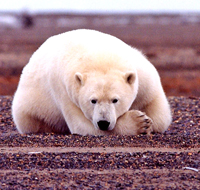 |
| Polar bear resting but alert. Credit: Susanne Miller |
- October 2 , 2007
The U.S. Fish and Wildlife Service today announced that it will give the public additional time to review and comment on nine new research papers analyzing polar bear population status and threats by extending its currently open public comment period until October 22, 2007.
News Release
USGS Studies
- New Information Leads to Reopening of Polar Bear Comment Period
-
 |
| Female polar with young. Credit: Susanne Miller/USFWS |
- September 18 , 2007
The Service is reopening the public comment period on its proposal to list the polar bear as a threatened species under the Endangered Species Act. The comment period will give the public an opportunity to review and respond to recent research conducted by USGS on polar bear populations, range-wide habitats and changing sea ice conditions in the Arctic.
News Release
USGS Reports
- USGS Announces Results of Polar Bear Research
-
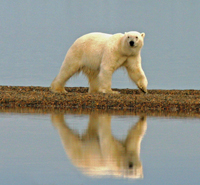 |
| Single polar bear walking. Credit: Susanne Miller/USFWS |
- September 07, 2007
In response to the Service's 2007 proposal to add the polar bear to the list of threatened and endangered species, Secretary of Interior Dirk Kempthorne asked USGS to analyze existing information and generate new scientific data, models and interpretations on polar bears and their sea ice habitat. USGS announced the results from a series of studies on polar bear populations, range-wide habitats and changing sea ice conditions in the Arctic.
Fish and Wildlife Service Statement
USGS Reports
- Dr. Goodall Visits Ferret Center
-
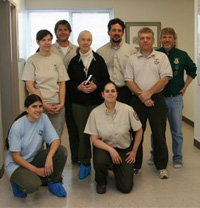 |
| Volunteers and biologists with the Service's Black-footed Ferret Conservation Center near Fort Collins, Colorado host Dr. Jane Goodall. Kneeling (L to R): Brenna Cerron, Ferreteer, Jennifer Bowers, FWS; middle row (L to R): Sharon Poessel, Ferreteer, Dr. Goodall, Terry Quesinberry, FWS; back row (L to R): Paul Marinari, FWS, Tom Allen, FWS, Mike Lockhart, FWS. Credit: USFWS |
- August 31, 2007
Dr. Jane Goodall, renowned scientist and conservationist, recently visited the Service's Black-footed Ferret Conservation Center near Ft. Collins, Colorado. Dr. Goodall has a longstanding interest in ferret recovery and conservation and has joined Service biologists in surveying animals at reintroduction sites. From a population of 18 ferrets in 1985 to a current estimate of 600 wild ferrets, the Black-footed Ferret Conservation Center is critical to the captive breeding and reintroduction effort.
- First Lady Tours Fort Hood Recovery Credit System Pilot Project
-
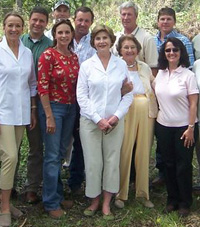 |
| First Lady Laura Bush (front row, center) poses with her mother, Jenna Welch (front row, second from right), staff from Texas A&M University, members of the Texas Watershed Management Foundation, Environmental Defense, and U.S. Army personnel from Fort Hood. Credit: Texas A&M University Institute for Renewable Natural Resources |
- August 24, 2007
First Lady Laura Bush and her mother, Jenna Welch, joined a tour of private lands near Waco, Texas associated with the Fort Hood Recovery Credit System Pilot Project. The U.S. Fish and Wildlife Service is a partner in the pilot project, created in 2006 to meet Fort Hood's need for flexibility in training activities and to advance recovery of the federally endangered golden-cheeked warbler. The Army purchases habitat credits from area landowners--who improve and manage habitat on their land--and uses those credits during endangered species consultations with other Federal agencies as military activities proceed. The endangered warbler benefits from increased management activities that address its specific habitat needs.
- Bald Eagle Soars Off Endangered Species List Secretary Kempthorne: The Eagle has Returned
-
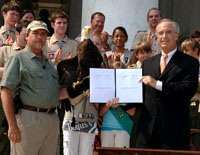 |
| Secretary Kempthorne emphasized the ongoing commitment of the Interior Department and the entire federal government to the eagle's continued success, noting that bald eagles will continue to be protected by the Bald and Golden Eagle Protection Act and the Migratory Bird Treaty Act. Credit: Tami Heilemann/DOI |
- July 2007
Secretary of the Interior Dirk Kempthorne announced the removal of the bald eagle for the list of threatened and endangered species at a ceremony at the Jefferson Memorial in Washington, D.C. After nearly disappearing from most of the United States decades ago, the bald eagle is now flourishing across the nation and no longer needs the protection of the Endangered Species Act.
News Release [06/28/07]
Bald Eagle Delisting Ceremony Highlights 
Service Bald Eagles Website
National Bald Eagle Management Guidelines [PDF]
Bald Eagles - Soaring Once Again
Joint Production of the National Zoo/USFWS
(contains copyrighted video material)
 [5MB] [5MB]  [56MB] [56MB]
Public Domain Footage of Bald Eagle
 Windows Media format Windows Media format
- Service Seeks Proposals from States for 2008 Endangered Species Grants
-
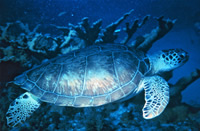 |
| Green sea turtles are one of the many species that have benefitted from an endangered species grant. Credit: NOAA |
- The U.S. Fish and Wildlife Service is seeking proposals from states and U.S. territories interested in obtaining federal grant assistance to acquire land or conduct planning for endangered species conservation efforts. For fiscal year 2008, the President's budget request for the Cooperative Endangered Species Conservation Fund would provide approximately $80 million in funding. Proposals must be submitted to the appropriate Service Regional Offices by August 24, 2007.
More Information
- Leader of Peregrine Falcon Conservation and Recovery Mourned
-
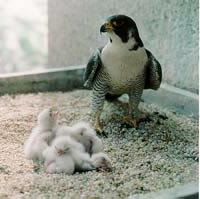 |
| Peregrine falcon and young. Credit: USFWS |
- June 2007
Brian James Walton, Coordinator of the Santa Cruz Predatory Bird Research Group, died unexpectedly on Friday, June 15, 2007. The Research Group was heavily involved in the conservation and recovery of peregrine falcons. Due to the banning of DDT and efforts of individuals like Brian Walton, the peregrine falcon, once nearly extinct, was removed from the endangered species list in 1999. The U.S. Fish and Wildlife Service recently presented an award to the Research Group in recognition of its "Pioneering efforts in partnership with the U.S. Fish and Wildlife Service to bring back the peregrine falcon."
More information
Brian Walton
Peregrine falcons
DDT and wildlife
- Discovery of Rare Bird Nest is Cause for Celebration
-
 |
| Kirtland's Warbler. Credit: Richard Baetson/USFWS |
- June 2007
Scientists and bird lovers are celebrating a milestone in the recovery of a highly endangered songbird as an active Kirtland’s warbler nest was discovered on private property in Wisconsin, the U.S. Fish and Wildlife Service announced today. The tiny Kirtland’s warbler, whose distinctive mating call can be heard up to a quarter of a mile away, lives primarily in jack pine forests in the northern lower peninsula of Michigan. However, the species has been seen in recent years in other areas, including Wisconsin, Ontario and the Upper Peninsula of Michigan.
More information
News Release
Fact Sheet [PDF]
Species Profile
Kirtlands Warbler Wildlife Management Area
Hear its Call  (at Cornell Lab of Ornithology) (at Cornell Lab of Ornithology)
- Endangered Mussels Get a Helping Hand
-
- On a recent Saturday morning, a team of biologists waded out into Mill Creek to collect some scaly participants for a mussel restoration effort. These included chub, dace, and shiners, fish species preferred by the larvae of endangered James spinymussels. Read about this restoration effort in the article, "The spinymussel clings on for life".
More information
List of threatened and endangered mussels.
Learn about the Mussel life cycle (requires free Flash player).
Articles from the Endangered Species Bulletin, February 2007:
• Mussels Enjoy the Waters of White Sulphur Springs[PDF]
• Mussels on the Road to Recovery at Genoa NFH [PDF]
Missouri State Unio gallery (images and video of freshwater mussels)
Bald Eagle will Retain Strong Federal Protections if Removed from Endangered Species List
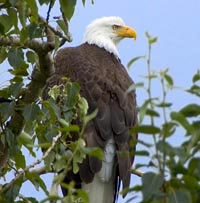 |
| Bald eagle in tree. Credit Steve Hillebrand/ USFWS |
The Service announced today that the bald eagle will continue to be strongly protected by federal law under a series of actions designed to govern management of eagles should they be removed from Endangered Species Act protection.
News Release
Learn More
Video Feature 
|
|
"Boots and Birkenstocks" Find Common Ground
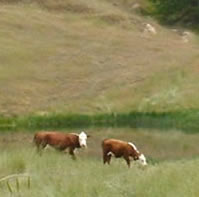 |
| Grazing cattle. Credit: USFWS |
California ranchers are working with environmental groups to keep ranching lands private--and benefit water quality and wildlife. By working together, they realize how much more can be accomplished.
This unusual alliance, inspired by the Fish and Wildlife Service's California and Nevada Operations Office, is featured in a Sacramento Bee article entitled "Guardians of the Range."
|
|
Bald Eagle Numbers Soaring
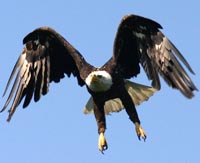 |
| Bald Eagle in flight. Credit: Phil Coleman/USFWS |
The Service announced new numbers showing the largest population of breeding bald eagles in the U.S. since World War II. Bald eagles in the lower 48 states have climbed from a low of 417 nesting pairs in 1963 to a new high of 9,789 breeding pairs estimated today.Bulletin
Learn More
Estimated Number of Bald Eagle Pairs (by State) [PDF]
|
|
Market-based Incentives Promoted for Endangered Species Habitat ProtectionThe U.S. Fish and Wildlife Service, Natural Resources Conservation Service, and the Association of Fish and Wildlife Agencies have teamed up to promote "habitat credits." This market-based approach offers incentives to landowners who preserve and enhance the habitat of endangered or at-risk species. While preserving habitat, landowners can profit by selling credits to parties who need to compensate for their environmental impacts.Natural Resources Conservation Service - News Release
Credit Trading Memorandum of Understanding [PDF]
Northern Spotted Owl Draft Recovery Plan Released
 |
| Northern Spotted Owl. Credit: John and Karen Hollingsworth/ USFWS |
The Fish and Wildlife Service has released a draft recovery plan for the northern spotted owl. The plan identifies the criteria and actions needed to stop the owl's decline, reduce threats and return the species to a stable, well-distributed population in Washington, Oregon and California.
News Release
Q's and A's[PDF]
Draft Recovery Plan [PDF]
For more information
Video: - 7MB - 7MB
MP4 - 4.7MB |
|
Bald Eagle Chicks Hatch Unaided on Catalina Island
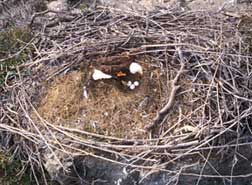
|
| Bald eagle nest. Credit: Peter Sharpe/Institute for Wildlife Studies |
For the first time since the mid-1940's, four bald eagle chicks have hatched unaided by humans on Catalina Island, off the coast of California. Biologists have been working diligently to re-establish breeding bald eagles on the Island after they disappeared from the region because of DDT contamination and other human impacts.Since 2001, the bald eagle restoration effort has been largely funded through the Montrose Settlement Restoration Program, a multi-agency effort to restore resources injured by the past releases of DDTs and other contaminantsChannel Islands Restoration
Bald eagle regulatory profile
More information about DDT from our Division of Environmental Quality
|
|
Service Announces Availability of the West Indian Manatee Five-year Review and Its Staff Recommendation to Reclassify the Species
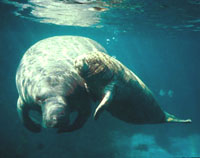 |
| Manatee and calf. Credit: Gaylen Rathburn/USFWS |
The U.S. Fish and Wildlife Service announced the completion and availability of its five-year status review of the West Indian manatee, a federally-listed species protected under the Endangered Species Act (ESA). This review includes both the Florida and Antillean subspecies of manatee.
Learn More
|
|
|
| Grizzly bear. Credit: Terry Tollefsbol |
The U.S. Fish and Wildlife Service is removing the Yellowstone population of grizzly bears from its status as threatened on the Endangered Species list.
Deputy Interior Secretary Lynn Scarlett made the announcement, saying the remarkable comeback of the species was a result of intensive recovery efforts
between federal and state agencies, conservation groups, and individuals.
• News Release [3/22/2007]
• Fact Sheet [PDF]
• Q&As [PDF]
• Grizzly Bear Video 
|
|
U.S. Fish and Wildlife Service Recognizes Conservation Partners
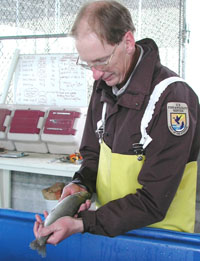 |
| Jay Bigelow with Lahontan cutthroattrout at Lahontan National Fish Hachery. Credit: Robert Pos |
The U.S. Fish and Wildlife Service’s Division of Fisheries and Habitat Conservation today recognized individuals and organizations whose cooperative efforts have helped conserve the nation’s fish and wildlife and the habitat they require to survive.
Fisheries and Habitat Conservation Legislator of the Year Awards were presented to Congressman Jim Saxton of New Jersey, Senator James Inhofe and Congressman John Sullivan of Oklahoma.
News Release [3/1/2007]
|
|
Fish and Wildlife Service Granted Extension on Final Decision to Delist Bald Eagle
|
| Bald Eagle. Credit: Mat Hewssue |
The U.S. Fish and Wildlife Service announced today that the final decision on whether to remove the bald eagle from the federal list of threatened and endangered species will be postponed. The Service has reached a court-approved agreement allowing the agency to make a final determination on the eagle's status no later than June 29, 2007.
• News Release [2/8/2007]
• Learn More
• Eagle Cam
|
|
|
|
